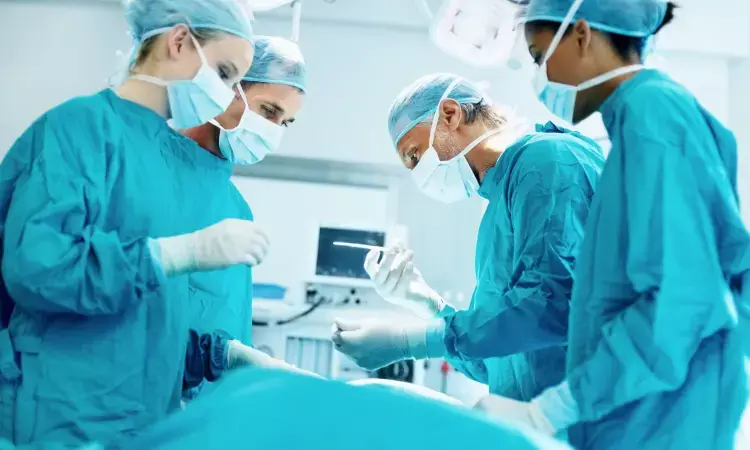- Home
- Medical news & Guidelines
- Anesthesiology
- Cardiology and CTVS
- Critical Care
- Dentistry
- Dermatology
- Diabetes and Endocrinology
- ENT
- Gastroenterology
- Medicine
- Nephrology
- Neurology
- Obstretics-Gynaecology
- Oncology
- Ophthalmology
- Orthopaedics
- Pediatrics-Neonatology
- Psychiatry
- Pulmonology
- Radiology
- Surgery
- Urology
- Laboratory Medicine
- Diet
- Nursing
- Paramedical
- Physiotherapy
- Health news
- Fact Check
- Bone Health Fact Check
- Brain Health Fact Check
- Cancer Related Fact Check
- Child Care Fact Check
- Dental and oral health fact check
- Diabetes and metabolic health fact check
- Diet and Nutrition Fact Check
- Eye and ENT Care Fact Check
- Fitness fact check
- Gut health fact check
- Heart health fact check
- Kidney health fact check
- Medical education fact check
- Men's health fact check
- Respiratory fact check
- Skin and hair care fact check
- Vaccine and Immunization fact check
- Women's health fact check
- AYUSH
- State News
- Andaman and Nicobar Islands
- Andhra Pradesh
- Arunachal Pradesh
- Assam
- Bihar
- Chandigarh
- Chattisgarh
- Dadra and Nagar Haveli
- Daman and Diu
- Delhi
- Goa
- Gujarat
- Haryana
- Himachal Pradesh
- Jammu & Kashmir
- Jharkhand
- Karnataka
- Kerala
- Ladakh
- Lakshadweep
- Madhya Pradesh
- Maharashtra
- Manipur
- Meghalaya
- Mizoram
- Nagaland
- Odisha
- Puducherry
- Punjab
- Rajasthan
- Sikkim
- Tamil Nadu
- Telangana
- Tripura
- Uttar Pradesh
- Uttrakhand
- West Bengal
- Medical Education
- Industry
Intraoperative GDHT fails to improve postoperative outcomes in patients undergoing open radical cystectomy

Radical cystectomy, a standard surgical procedure for treating invasive bladder cancer, is accompanied by complications. This includes substantial blood loss, infections, ileus, wound complications, venous thrombosis, and metabolic disturbances. These complications adversely impact the treatment outcomes. Perioperative goal-directed haemodynamic therapy (GDHT) refers to administration of fluids with/without inotropes or vasoactive agents against explicit measured goals to augment blood flow.
A recent study investigated the effect of intraoperative GDHT on postoperative complications in patients who underwent open radical cystectomy. Intra-operative GDHT fails to improve postoperative outcomes in these patients, says Dr Hyun-Kyu Yoon and colleagues in their study published in BMC Anesthesiology.
In this prospective, single-centre, randomized controlled trial, 82 patients were scheduled for open radical cystectomy. Thirty-nine patients in the GDHT group received the stroke volume index- and cardiac index-based hemodynamic management using advanced hemodynamic monitoring. In the control group, 36 patients received the standard care under the discretion of attending anesthesiologists during surgery. Researchers measured the incidence of a composite of in-hospital postoperative complications during hospital stays as the primary outcome.
Key findings of this study are:
- The final analysis had 75 patients.
- They reported no significant difference in in-hospital postoperative complications incidence (71.8% vs. 83.3% with a risk difference of -0.12 between the groups.
- There were similarities in the amounts of intraoperative fluid administered between the groups (2700 vs. 2900 ml), with a median difference of -200.
- Two groups had comparable secondary outcomes. This included the incidence of seven major postoperative complications, duration of hospital and ICU and grade of complications.
- There were no significant differences between the GDHT and control group pertaining to postoperative eGFR, serum creatinine, and C-reactive protein.
In our study, they said Intraoperative GDHT did not improve postoperative outcomes.
Previous research shows that high-risk patients may benefit more from GDHT than non-high-risk patients. Most patients had ASA physical status II; they said the benefit from GDHT for our patients may have been less than that for high-risk patients.
Limitations of the study include sample size calculation based on the total complication rate of 40%, retrospective nature, uncertainty regarding the accuracy of post-induction assessment, exclusion of patients with severe systemic diseases and limited generalizability.
Reference:
Yoon, HK., Hur, M., Kim, D.H. et al. The effect of goal-directed hemodynamic therapy on clinical outcomes in patients undergoing radical cystectomy: a randomized controlled trial. BMC Anesthesiol 23, 339 (2023). https://doi.org/10.1186/s12871-023-02285-9
BDS, MDS in Periodontics and Implantology
Dr. Aditi Yadav is a BDS, MDS in Periodontics and Implantology. She has a clinical experience of 5 years as a laser dental surgeon. She also has a Diploma in clinical research and pharmacovigilance and is a Certified data scientist. She is currently working as a content developer in e-health services. Dr. Yadav has a keen interest in Medical Journalism and is actively involved in Medical Research writing.
Dr Kamal Kant Kohli-MBBS, DTCD- a chest specialist with more than 30 years of practice and a flair for writing clinical articles, Dr Kamal Kant Kohli joined Medical Dialogues as a Chief Editor of Medical News. Besides writing articles, as an editor, he proofreads and verifies all the medical content published on Medical Dialogues including those coming from journals, studies,medical conferences,guidelines etc. Email: drkohli@medicaldialogues.in. Contact no. 011-43720751


